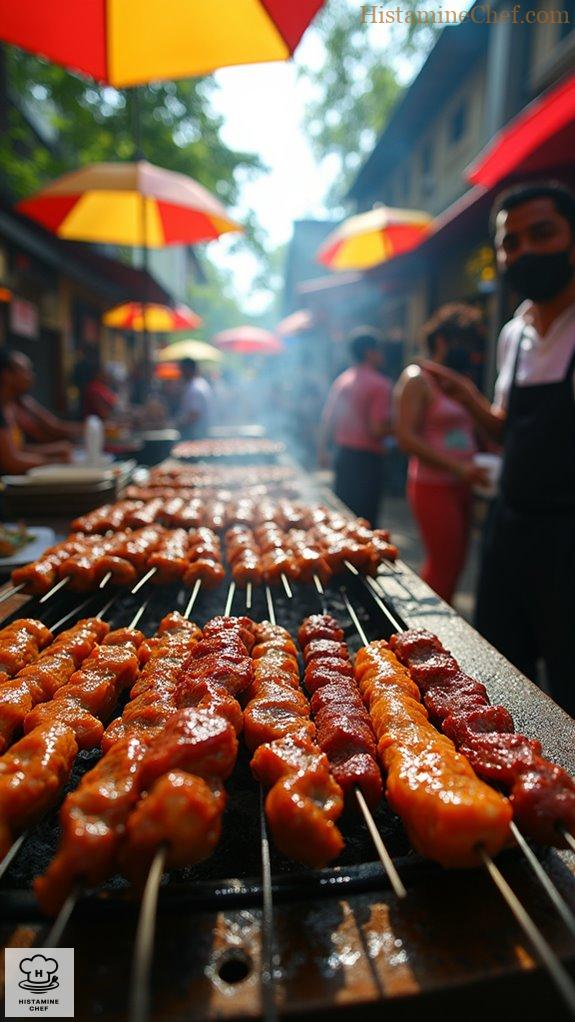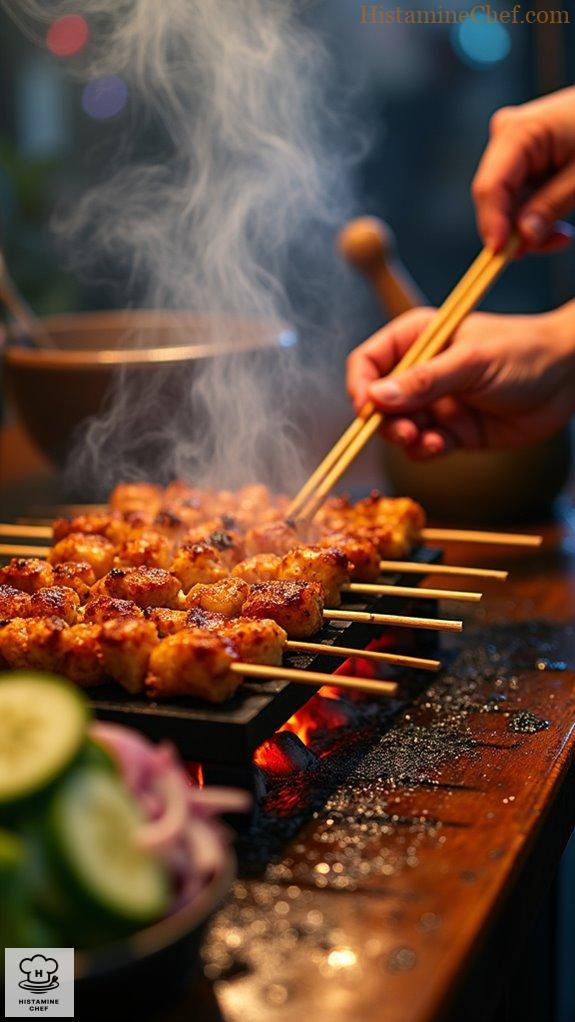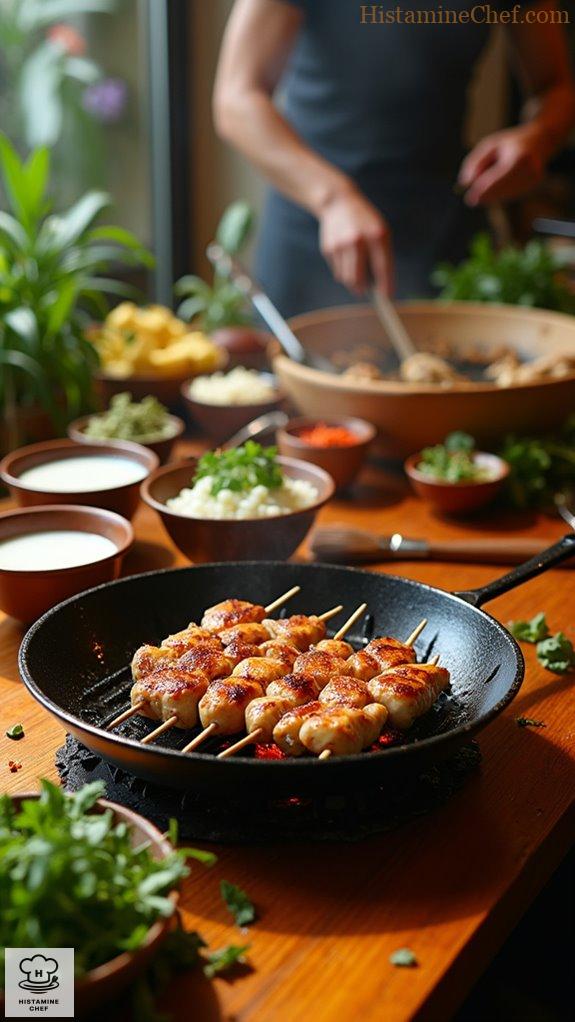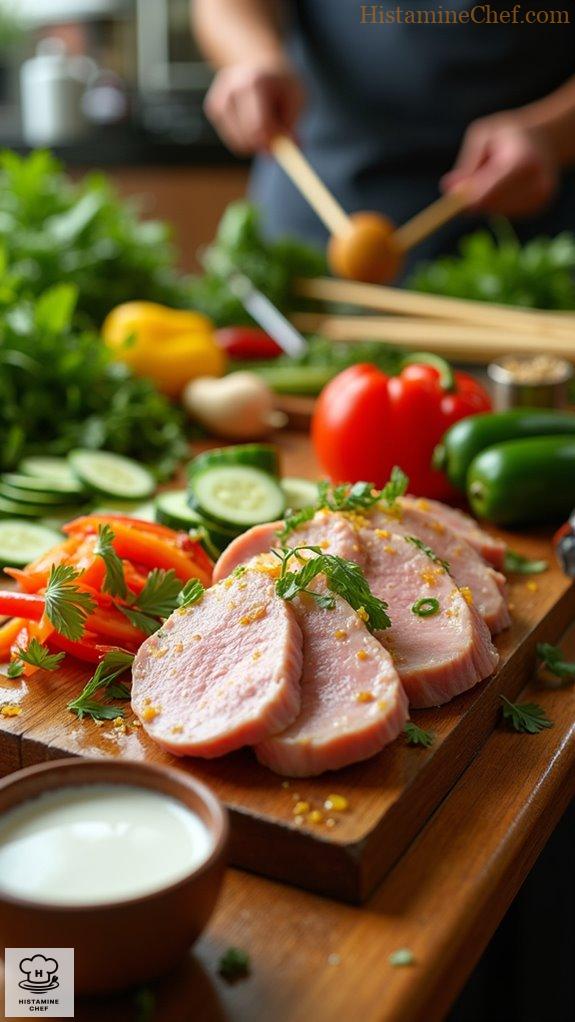Ready to whip up a lower histamine Indonesian sate that’ll leave your taste buds dancing? Imagine this: tender chunks of chicken marinated in a zesty blend of extra virgin olive oil and distilled white vinegar, skipping the soy sauce and garlic. Grill those skewers (don’t forget to soak the bamboo in water first) until beautifully charred. Add a tropical coconut dipping sauce for an irresistible finish! Want to discover how to elevate this dish even further?
Dynamic Culinary Scene, Jakarta

Jakarta’s vibrant street food culture is a reflection of Indonesia’s rich culinary heritage, where food stalls and mobile vendors line the streets, offering an array of tantalizing dishes that reflect the diverse flavors of the archipelago.
The history of street food in Indonesia dates back centuries, originally influenced by various cultures such as Chinese, Indian, and Middle Eastern traders who brought their culinary traditions to the region. Over time, local ingredients and cooking techniques melded into unique dishes that are now beloved staples, like Sate, which consists of skewered and grilled meat served with a savory peanut sauce.
The bustling streets of Jakarta, especially neighborhoods like Kebon Kacang and Menteng, are renowned for their culinary offerings, where night markets and street vendors create a lively atmosphere filled with the sizzle of grills and the aroma of spices.
This dynamic street food scene not only satisfies the appetites of locals and tourists alike but also fosters a sense of community, as people gather to enjoy the flavors that represent the heart and soul of Indonesian culture.
Charcoal-Grilled Over Open Flames

To prepare Indonesian Sate, street vendors start by marinating small skewers of fresh meat, often chicken or beef, in a mixture of sweet soy sauce, garlic, and spices for several hours.
Once marinated, they thread the meat onto bamboo skewers and grill them over open flames fueled by charcoal. This imparts a smoky flavor and crispy exterior while keeping the meat tender and juicy.
The vendors continuously baste the skewers with the remaining marinade during grilling to enhance the flavor and prevent the meat from drying out.
As the satay cooks, they skillfully turn the skewers to guarantee even cooking, readying them for serving with a side of peanut sauce and fresh accompaniments like cucumber and onion.
Ingredients:
- 500g chicken or beef, cubed
- 3 tbsp sweet soy sauce
- 2 cloves garlic, minced
- Bamboo skewers, soaked in water
- 1 tsp coriander powder
- 1 tsp cumin powder
- 1 tbsp vegetable oil
- Fresh cucumber and onion for serving
Cooking Steps:
- Marinate meat with soy sauce and garlic.
- Thread marinated meat onto bamboo skewers.
- Preheat charcoal grill until hot.
- Grill skewers over open flames.
- Baste with remaining marinade while cooking.
- Turn skewers for even cooking.
- Grill until meat is tender and cooked.
- Serve with peanut sauce and vegetables.
Grill Marinated Skewers Indoors

To grill marinated skewers indoors for Indonesian Sate, start by marinating your choice of allowed meat, such as chicken or beef, in a mixture of coconut milk, salt, and your favorite fresh herbs for at least two hours.
Preheat a grill pan or air fryer to a medium-high heat.
Thread the marinated meat onto skewers (if using wooden skewers, soak them in water first).
Lightly oil the grill pan or air fryer basket, and cook the skewers for about 10-15 minutes, turning occasionally, until they reach a safe internal temperature and have a nice char.
Cooking Steps/Ingredients Change:
- Use chicken or beef as meat
- Marinate with coconut milk and herbs
- Preheat grill pan or air fryer
- Optionally soak wooden skewers
- Lightly oil grill pan or basket
- Grill for 10-15 minutes
- Verify proper internal temperature
Low Histamine Variation of Sate

Histamine intolerance can considerably complicate the enjoyment of street food due to the high levels of histamine present in many ingredients. A significant factor contributing to histamine levels in food is the aging process of ingredients, which can lead to higher histamine production.
Street food often incorporates fermented products, aged meats, and various high-histamine vegetables, making it challenging for those susceptible to histamine-related reactions. Eating street food can be problematic for individuals with histamine intolerance because many typical ingredients are restricted according to the SIGHI list.
For instance, common elements like marinated meats or sauces often contain high-histamine compounds, leading to potential adverse reactions. Additionally, the lack of freshness and control over food preparations may increase the risk of histamine buildup.
Low Histamine Variation of Sate Cooking Instructions
- Use freshly minced or cubed chicken or turkey as meat.
- Substitute soy sauce with distilled white vinegar for marinades.
- Avoid adding garlic or onion; use fresh herbs instead for flavor.
- Marinate meat in extra virgin olive oil and vinegar only.
- Skewer meat on bamboo sticks without any added preservatives.
- Grill or pan-fry the skewers until fully cooked and juices run clear.
- Serve with allowed vegetables like cucumber or bell peppers, sliced thin.
- Offer a side dipping sauce made from coconut milk and spices.
- Don’t include peanut sauce; use honey for sweetness instead.
- Confirm all cooking utensils are clean to avoid cross-contamination.
Additionally, consider using dairy-free cheese alternatives that are suitable for low histamine diets to enhance the overall flavor while keeping your meal compliant.
Video Summary
Indonesian Sate has its roots in Java, celebrated for its rich flavors and aromatic spices.
We’ll cover the authentic street version first, then a home-cooked low histamine version. Street vendors begin by marinating chunks of chicken or beef in a mixture of sweet soy sauce, garlic, turmeric, lemongrass, and coconut oil.
This marination typically lasts several hours or overnight. Skewers are then prepared, traditionally made from bamboo. The meat is threaded onto the skewers, ready for grilling. A charcoal fire provides that iconic smoky flavor.
The skewers are grilled for about ten to fifteen minutes, turning frequently. Once cooked, the sate is plated and usually served with peanut sauce or a spicy sambal.
For the home low histamine version, we substitute sweet soy sauce with coconut aminos for a similar flavor.
Garlic can be reduced or eliminated, as well as lemongrass if preferred. Instead of beef, use fresh chicken as it’s better tolerated. The coconut oil remains, providing richness to the dish.
Skewering can be done using sanitized metal or bamboo sticks. The grilling process can still involve a charcoal grill or a stovetop grill pan.
Cook the skewers for about ten to twelve minutes, ensuring they’re cooked through. Serve your low histamine sate with a coconut dipping sauce made from coconut milk and sweeteners like agave syrup.
The final dish has tender, flavorful pieces of chicken, beautifully charred and succulent. It looks mouthwatering, boasting a golden-brown color.
Don’t forget to click the link in the description for the full recipe!


Leave a Reply